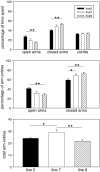Behavioral traits are affected by selective breeding for increased wheel-running behavior in mice
- PMID: 20369280
- PMCID: PMC2886896
- DOI: 10.1007/s10519-010-9359-8
Behavioral traits are affected by selective breeding for increased wheel-running behavior in mice
Abstract
Voluntary physical activity may be related to personality traits. Here, we investigated these relations in two mouse lines selectively bred for high voluntary wheel-running behavior and in one non-selected control line. Selection lines were more explorative and "information gathering" in the open-field test, either with increased upright positions or horizontal locomotion toward the middle ring. Furthermore, one of the selection lines had an increased risk-taking behavior relative to the control line in approaching a novel object placed in the center of the open field. However, anxiety behavior was increased in selection lines during the plus-maze test. Maze learning was not statistically different among lines, but routine behavior was increased in both selection lines when the maze exit after 2 days of testing was displaced. Specifically, in the displaced maze, selected mice traveled more frequently to the old, habituated exit, bypassing the new exit attached to their home cage. Although the generality of the results would need to be confirmed in future studies including all eight lines in the selection experiment, the increased routine and exploratory behavior (at least in the lines used in the present study) may be adaptive to sustain high activity levels.
Figures






References
-
- Bell RR, Spencer MJ, Sherriff JL. Diet-induced obesity in mice can be treated without energy restriction using exercise and/or a low fat diet. J Nutr. 1995;125:2356–2363. - PubMed
Publication types
MeSH terms
LinkOut - more resources
Full Text Sources

